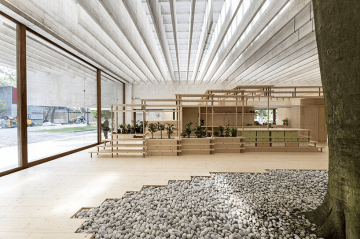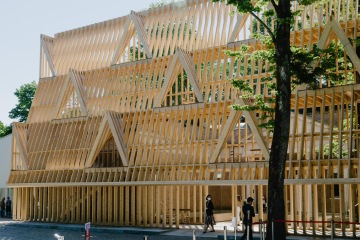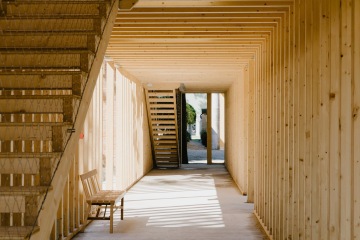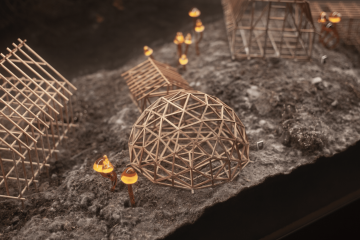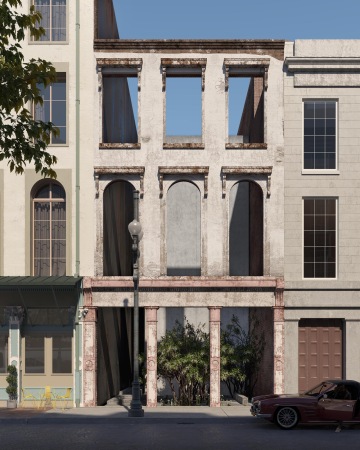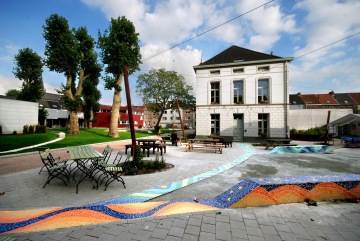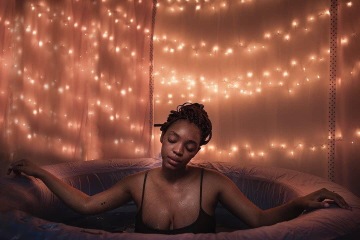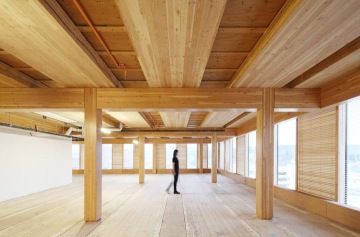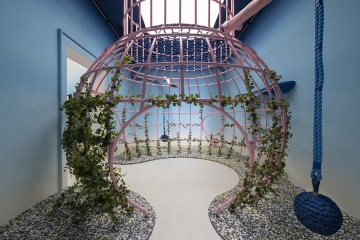
Venice Architecture Biennale: How Will We Live Together with Manijeh Verghese + Madeleine Kessler
Part two of our Design and the City episode covering the long-awaited 17th Venice Architecture Biennale features British pavilion curators, Manijeh Verghese and Madeleine Kessler as they explore accessibility and our increasingly privatised public spaces, in the United Kingdom and beyond. Photo by Cristiano Corte © British Council
The postponed 17th Venice Architecture Biennale asked its 112 participants to consider the question, “How will we live together?”. A question originally posed in 2019 by curator and architect, Hashim Sarkis far before our collective 2020 experience. Sarkis originally asked participants “to imagine spaces in which we can generously live together” Answers from 46 countries materialized into the exhibition of 2021. After a year spent living apart, the theme is both hauntingly fitting and reifies our disconnection.
It has signalled something, a community eager to reconnect and a deeper understanding of just how interwoven we are with our spaces spanning the full spectrum of human existence. The exhibition explores that spectrum across five scales: Among Diverse Beings, As New Households, As Emerging Communities, Across Borders, and, As One Planet.
Listen to part two of our special episodes on the 17th Venice Architecture Biennale on Design and the City now:
British Pavilion: The Garden of Privatised Delights
The Garden of Privatised Delights is the exhibition at this year’s British Pavilion directly addressing the question of how we will live together by exploring the increasing privatisation of public spaces. Laced with proper whit and humor, curators Manijeh Verghese and Madeleine Kessler explore tangible and intangible examples of inclusion as they exist in between those realms of which we live out our lives.
They use their platform to examine the kinds of spaces rooted in British culture, asking questions that challenge the polarisation of private and public, in a self-described joyful manner. This polarisation is one that often leads to divisions within British society, yet, can be understood as universal. Their vibrant approach makes it all the more accessible, inviting a wider audience to the conversation.
Questions like, could the pub become more than a place for drinking, but a versatile center for civic action? How can rethinking facial recognition technology free our collective data for public benefit? Could the high street go beyond commercial interest and become a place of diverse exchange? Can we design new spaces in the city for teenagers to occupy on their own terms?
Manijeh Verghese and Madeleine Kessler are the founders of Unscene Architecture and have been commissioned by the British Council to represent the UK at the Venice Architecture Biennale 2021. I joined the both of them in conversation after returning from Venice.
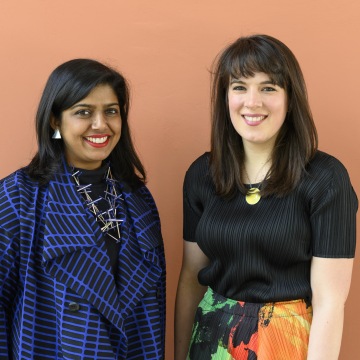
Alexandra Siebenthal, reSITE: I'm catching up with the curators of the British pavilion, the garden of privatised delights. And thank you both so much for joining us.
Madeline Kessler: I'm Madeline Kessler, and I'm an architect and co-curator of the British pavilion with Manijeh Verghese.
Manijeh Verghese: And Hi, I'm Manijeh Verghese and together with Maddie, we run a practice called Unscene Architecture that's really interested in this topic of privatised public space, but also how to engage people in having more agency around how their cities and spaces are kind of accessed, used, owned, and experienced.
Alexandra: Fantastic. And do you want to know how we first met?
Alexandra: Sure! Yeah!
Madeline: Actually, it kind of feeds into the pavilion. That's why I like the story, then, I would love that, because anything personal or just like something that maybe you can't just get from, you know, to deepen the experience of it.
Alexandra: I think that's great. So please, please share it with us. I'd love that.
Madeline: So we first met when we were studying at the architectural association, in the queue for the ladies toilets, which we love as a meeting place because toilets are actually really important in allowing access to public space. And it's something that's not really spoken about enough. And it's actually sort of fed into one of the installations within our pavilion called "Toilet," which looks at opening up the toilets in the basement of the British pavilion to the public for the first time.
And then after that, we taught a summer school together in 2015, all about the pub, where we're looking at the pub as an interior type of privatised public space. And a positive example of privatised public space, which sort of goes back generations within the UK. But pubs are closing up and down the country. And with that, we're sort of losing this kind of communal facility, which is sort of the extension of people's living rooms, the modern day public toilets.
You know, it's much more than just a sort of watering hole where people go to drink, it's a real kind of community space. And so through that, we became really interested in this topic of privatised public space and how the public and private spaces within our city sort of work together. And that again, has really been the starting point of exploring this topic within the British Pavilion.
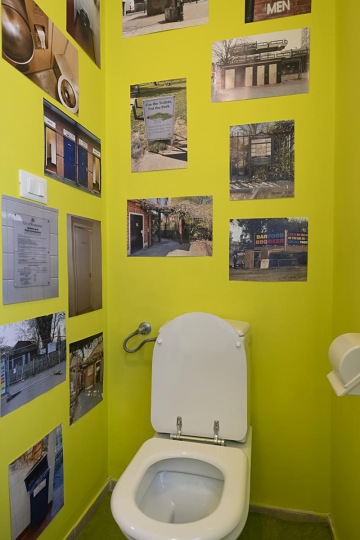
Alexandra: I feel like I kind of have a funny story with the toilet aspect of the pavilion. I was with two other women. One of which is my colleague, and we exited the pavilion and one of them was expressing that she needed to find a bathroom to use. And for some reason, they did just go around the side of the building actually looking for the toilets, and then realised that that was actually part of the pavilion, we just kind of laughed and sort of, you know, talking about that actual lack of accessibility.
Manijeh: But it must be frustrating to like then see a toilet on display, but not actually be able to access or use it, which is kind of what well, originally, we were hoping to open up that toilet in the basement and then but we couldn't because of legislation and kind of Italian building code that prevented us from doing so.
We still decided to put it on display in order for people to realise that there are so many toilets that could be made open, like made accessible to the public, if it wasn't for these policies that are holding us back, and these kinds of weird demarcations between public and private. And that actually things like toilets in the basement of the British pavilion could really be a really useful resource for people visiting the Biennale, and hopefully that will happen in the future.
Madeline: Yeah, I mean, that's exactly what this exhibit is all about, what you and your friend experienced. And we were super interested because we went over to Venice when they were installing the British pavilion for the art Biennale. And that was when we realised that the British pavilion was one of the few pavilions which has toilets in its basements. And we found that it was this real social hub because you had all these other people from other pavilions coming to use the toilets.
And we were really interested then in how we could start to open up the toilets, to allow other people to use them, rather than just those working in the British Pavilion. And as Manijeh says, yeah, we were just confronted by all these building regulations, because they're not fully accessible and the way they're kind of hooked up to the system. Which, yeah, then provoked us to sort of allow this weird glimpse in which provokes this conversation about all the red tape, which prevents us from allowing us to open up existing facilities.
Alexandra: Absolutely, it's not very human is it? No, I thought it was funny and had a laugh about it. And I think it was a very well executed point. But you know, it really was a tangible experience.
Madeline: That's great to hear. That's really great feedback, thank you.
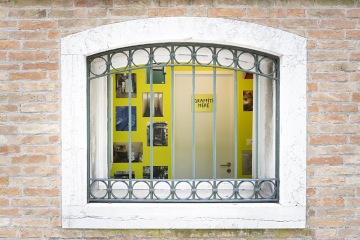
Alexandra: You're welcome. So on that note, I guess we kind of started with the end. But maybe we can kind of go in and talk about and you know, all the different aspects of public versus privatisation that you explored within your exhibition. I really loved the sort of triptych of concepts that you put together to express that.
Manijeh: The title of the British pavilion this year is The Garden of Privatised Delights. And that came from our main inspiration, which was this triptych by the Dutch painter Hieronymus Bosch, called the Garden of Earthly Delights. And we were really inspired by the three panels of the triptych and how this kind of middle ground of Earth is framed between two extremes. So the Utopia of Heaven on one side and the Dystopia of Hell on the other.
How can we act now to kind of open up these privatised public spaces and really rethink them in terms of who can access them? Who can use them? Who can own them? And how can we make them kind of more adaptable to the challenges we face today?
And so when we were entering the competition for the British pavilion, like two years ago now, we were actually really interested in how we could reframe this through our version of the painting, The Garden of Privatised Delights', that looks at privatised public spaces, this really rich opportunity for architects to work with the public and intervene, but that also sits between two extremes. So the utopia of public lands before the Enclosures Act of the 18th century here in the UK, and then the dystopia of total privatisation as this kind of future that we seem to be heading towards. And so how can we act now to kind of open up these privatised public spaces and really rethink them in terms of who can access them? Who can use them? Who can own them? And how can we make them kind of more adaptable to the challenges we face today?
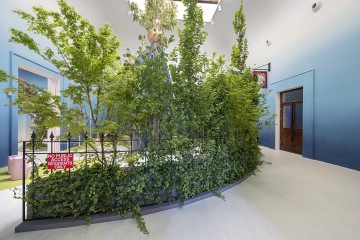
Alexandra: Absolutely. And even to start, I really loved your use of humour, kind of within the exhibition that you know, when you walk in, you notice the sign that warns, "Contains Strong or Violent Language". And I actually took that quite seriously like, okay, you know, these regulations that they have to warn people about. And then the first message you're greeted with is, uh, "No Public Access - Residents Only". And I was like, “Oh, okay, I see. I see where this is going”. So maybe would you want to talk a little bit more about that, like, walk us through the exhibition itself?
Madeline: Yes. So as you enter through the doors of the British pavilion, you're entering into that middle ground of the triptych. So you're entering into that weird kind of private, public space that we're all living in today. And you're sort of confronted by these railings. And you can see there's something behind the railings, but you can't access it. And as you say, there's sort of a sign saying, "Residents Only". So you're kind of forced on into the next room. And you have to sort of go around to the whole pavilion until you find yourself back inside the garden square. And that kind of entrance experience is really setting up the issue with privatised public space, that it's not accessible to everyone.
And what we really are exploring is how we can make our public spaces more accessible and more inclusive. And so you're taken on this journey through the pavilion, you sort of follow this garden path through the garden of privatised delights. So the next room is the pub. And then you go into the Ministry of Collective Data, which is sort of exploring collective ownership of data and facial recognition technology. And then you go on to the high street, which is looking at how sort of there was this really high rate of closure of shops on the high streets at the moment. So how can we rethink our high streets to be kind of real kind of social centres of care? And then into the Ministry of Common Lands, which is looking at bottom-up, sort of approaches to land ownership and citizens assemblies, and then into Play Without Grounds, which is looking at how there's just nowhere in our cities for teenagers and young people anymore.
We were interested in how we can actually encourage people to kind of be creative and sort of take ownership of their spaces.
So how can we design spaces with them, rather than for them to allow them to take ownership of these kinds of frameworks within the city, and then eventually find themselves back into The Garden of Delights? And this time, you're sort of inside the square, the railings have sort of disappeared, and they've been repurposed into pieces of furniture. We were really inspired by how in World War Two, in fact, a lot of the railings around these garden squares, which you find in Georgian cities across the UK, like London, Bath—and they were, were taken down to be melted for ammunition. And what you actually found was, for the first time, anyone could use these garden squares. And there's loads of really amazing texts from the time, from people like George Orwell, talking about how amazing it was to suddenly mix with people you'd never otherwise meet
But then unfortunately, after the war, a lot of the railings were reinstated, which then closed off the spaces once more. And so we're looking at how you know, these really simple design moves can make a huge difference to people's experience of the city. And at the same time, kind of the importance of legislation and policy within this. And then I suppose, the signage that you mentioned, that's kind of a recurring theme throughout the exhibition. So we're really interested in how often in privatised public spaces, you have a lot of signage telling you what you can't do.
So you're always told you can't you can't play ball games—you can't do this, can't do that. We were interested in how we can actually encourage people to kind of be creative and sort of take ownership of their spaces. And so we've got all this signage, sort of encouraging you to do things, so to listen, share, act in the high streets, to plant seeds in the garden square, to play in the playground, you know, to graffiti in the toilet. And so yeah, we really wanted to just kind of flip that on its head, to make your experience of public space much more enjoyable.
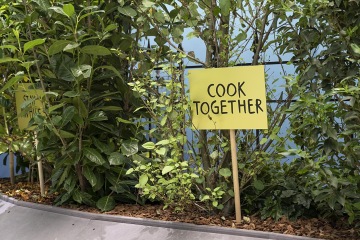
Manijeh: And the painting becomes this really interesting visual reference. So in addition to being our kind of conceptual inspiration, it's also something that we constantly referenced in the design of each of these spaces, because we wanted you to be able to recognise spaces that you would find in a typical UK town or city like the garden square, or the pub or the high street.
But we also didn't want to just reconstruct these, as you know, perfect replicas, we wanted to show how architects and the role design could play in actually rethinking these spaces to open them up, but also make them maybe more adaptable to new uses and more diverse programmes. And, and therefore they have like this kind of surreal colour scheme taken from the Bosch painting, but also these playful and sculptural forms.
And we worked a lot with our graphic designer Kellenberger-White, to think of also typefaces. So they came up with this really fun, almost like finger painted font for some of the signage that's in the garden square inside the spaces once they've been kind of rethought. And like Maddie was saying about, you know, encouraging you to be creative and to act in different ways. They captured that through this kind of, the act of as though you dipped your finger into a pot of paint and like, made the signage yourself. And I think that links back to this idea you picked up on about humour was really important to us that people coming to the exhibition really felt like this was their space to explore and use as they saw fit. And we didn't want to be too didactic, about what you can and cannot do in the space or what you should be doing. And instead, we actually want to use the exhibition as this kind of experimental testing ground where we're actually hoping that over the duration of the Biennale, we can learn from how people occupy these spaces and use them in different ways.
We wanted to grapple with it in a really joyful way to challenge everyone to become part of this conversation, because when it's tackled in this very kind of serious academic way, you lose a lot of your audience.
Madeline: I suppose, like you say, you know, this is a very serious topic that we're grappling with. But we wanted to kind of grapple with it in a really kind of joyful way to kind of challenge everyone to become part of this conversation, because when it's sort of tackled in this very kind of serious academic way, you lose a lot of your audience.
And it's really important for us that we have everyone involved in this conversation from community groups, to landowners, to developers, to policymakers, to architects, and one way for us to do that is to create these spatial immersive experiences that everyone can enjoy. Everyone can sort of experience, everyone can test out different ways of using it. And the pavilion felt like a really exciting opportunity to create this testing ground for these installations, which we can then take back to the UK and start to place in privatised public spaces around the UK, and really start to test how we open up these spaces to become more inclusive.
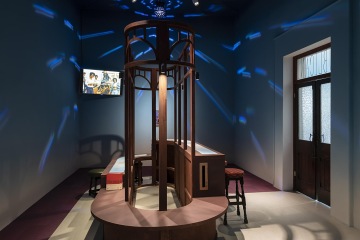
Alexandra: Well, I really felt all that and I that's, you know, I really appreciate your attempt to widen that conversation by making it accessible. And I think that's a big reason why, you know, it impacted me the most. And I can imagine it will resonate with a lot of people. So I hope so,
Manijeh: I mean, the idea is also that, like may—that when we were initially kind of designing these spaces, our hope was that this pavilion becomes the kind of platform for a wider project. And that, although it's the British pavilion, and we're looking at kind of quintessential British spaces in many ways, privatised public space is such a global phenomenon.
We've tried to design it as a kind of manual that will allow people to kind of think about their public spaces differently, and also see that they have a lot of agency in kind of transforming them, and using them differently.
And although we might be putting on display a pub or a high street, we hope that people can find parallels with their local contexts and examples of privatised public space that they would recognise in their own environments. And that a lot of the kinds of strategies that we're suggesting, of how to open these spaces up, could be kind of applied and taken forward, regardless of where you live, and the public spaces that are near you.
And we both I think, even our exhibition catalogue, we've tried to design it as a kind of manual that will allow people to kind of think about their public spaces differently, and also see that they have a lot of agency in kind of transforming them, and using them differently.
Madeline: I mean, the whole exhibition was sort of inspired by widening access to this conversation. And we sort of recognise that a lot of the time architecture exhibitions, they're quite dense and difficult to sort of absorb and understand unless you're in that very sort of academic architecture world. And so there's a lot of text on walls, a lot of references. And we really wanted to step away from that to create these experiences that everyone could understand. And we were quite interested in also how the second biggest group of visitors to the Biennale are Italian school children. So you know, how do we get like younger people who aren't architects to also engage in this exhibition? Because it's so important to have them as part of this conversation about their city.
Alexandra: Absolutely. Um, so aside, maybe from like, you know, your story of how you met, do you have any other personal experience that really inspired this, in any of these aspects that you've included: high street, the pub, private gardens, and more?
Madeline: I mean, so we both studied at the Architectural Association, which is a sort of part of an old Georgian square. And I think what we recognised when we were studying there is that there's this kind of really big green space at the centre of it. And it's now surrounded by what were townhouses, but are now sort of academic institutions and offices. And very few people were able to access that square and at lunchtime, you just see everyone sitting around the railings, eating their lunch, sort of on the pavement, when there was this piece of, like, amazing greenery right at the centre of the city just there. And I think that probably kind of subconsciously embedded itself in our minds as we were studying.
And then when we were choosing the typologies for the pavilion that was just kind of like a really obvious one for us, because it really helps to very clearly set out the kind of real issues with privatised public space.
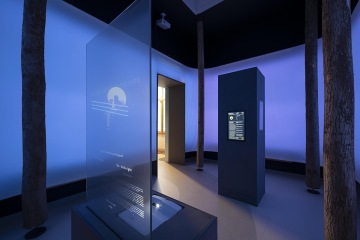
Manijeh: Yeah. And then as Maddie said previously, like we—the kind of our interest in privatised public space grew out of the summer school looking at the pub, and that was something that really resonated with us because we have felt that the pub has often become the kind of modern day public toilet and in our own lives, you know, we have often met together and brainstormed ideas in the pub, and, you know, used it as everything from a living room to a waiting room. And that was a really rich topic that we explored in the summer school, but then we wanted to expand on the pavilion.
They're a way to propose a more bottom-up approach to decision-making rather than top-down and to look at the tangible assets of land versus the intangible assets of data.
And I think, you know, it's been a kind of ongoing trend over the last several years, if not decades, that a lot of these spaces in the UK are at risk of, you know, disappearing because of, you know, a lack of support or funding. And also, because of the way cities are changing, I think the high street is under threat, because a lot of retail is moving online, youth centres are closing because there's lack of funding to support them. And so these kinds of spaces that are so important to bring people together in the public realm are just disappearing. And so it felt really urgent that the pavilion address these topics, and we personally have, like, you know, experienced, like the lack of public toilets and the need for these kind of social hubs that can bring people together.
So what we really wanted to do was to bring people that were already doing interesting research on this topic. So we were really lucky to work with five other practices in kind of bringing to life this kind of concept around privatised public space and see what, what could change or what could be done differently about breathing new life into these spaces and inventing some new ones.
So the government ministries in particular, they're a kind of way to propose a more bottom up approach to decision making rather than top down and to look at the tangible assets of land versus the intangible assets of data. And really think about how, like, the public can decide how land and data are used for collective benefit. So for us, it was really important that we took our personal experiences and that of our team and then translated it into something that had longevity, but also that would resonate with a wider group of people.
We do more than just build, like, we're great communicators, and how therefore can we bring different people around a table to transform our cities?
Madeline: I think as well, like rethinking the role of the architect within the city, and what it means to be an architect today. So how architects, like, we do more than just build, like, we're great communicators, and how therefore can we bring different people around a table to transform our cities? I mean, so often, I've worked on a project, and you'll just be like, why is the site even here? Like, by the time we get involved in these conversations, often it's far too late. So quite, I think we're quite interested in exploring how can architects become part of the conversation and much earlier at a much more strategic level, so that we can really be part of these kind of visionary processes right from the outset? Right the way down to the final sort of detailed design.

Alexandra: That's a great point. And it's something we're trying to explore as well at reSITE, of just kind of the importance of having lots of different interested parties involved in it. in regards to just, you know, again, public private space, you know, some might argue that it's only fair, and I use air quotes, to use a property if you take care of it, but how might you inspire those who who are using public space to care for that space collectively?
Manijeh: I think it's a really interesting question, because so much of the argument around what should be public and what should be private and even privatised public space, the way that they're currently being designed in new developments, it's often around issues of maintenance, and security that like governs like how they're designed, but also how they're maintained and encouraging that sense of care is really important.
And I think, you know, it's been a kind of ongoing trend over the last several years, if not decades, that a lot of these spaces in the UK are at risk of, you know, disappearing because of, you know, a lack of support or funding. And also, because of the way cities are changing, I think the high street is under threat, because a lot of retail is moving online, youth centres are closing because there's lack of funding to support them. And so these kinds of spaces that are so important to bring people together in the public realm are just disappearing. And so it felt really urgent that the pavilion address these topics, and we personally have, like, you know, experienced, like the lack of public toilets and the need for these kind of social hubs that can bring people together.
What we really wanted to do was to bring people that were already doing interesting research on this topic. So we were really lucky to work with five other practices in kind of bringing to life this kind of concept around privatised public space and see what, what could change or what could be done differently about breathing new life into these spaces and inventing some new ones.
We do more than just build, like, we're great communicators, and how therefore can we bring different people around a table to transform our cities?
In the ministry of common land, these big paper machine heads that were made by school children, and when they were making them, they were told stories about the kind of influential figures in the discourse around public lands. So everyone from Jane Jacobs to Colin Ward, and then they got really inspired. And then when they were making these heads, they had this additional significance. And then the fact that then those heads now sit in this ministry of common land, and they look down on you as in the space of the ministry. As you know, people come together to take decisions about their spaces, it feels really powerful, and there's the kind of I guess, the design almost manifests this kind of process that, you know, the more you know about these spaces, the more you know what you're able to do in these spaces, the more you should be able to care for them.
Madeline: I think as well, like rethinking the role of the architect within the city, and what it means to be an architect today. So how architects, like, we do more than just build, like, we're great communicators, and how therefore can we bring different people around a table to transform our cities? I mean, so often, I've worked on a project, and you'll just be like, why is the site even here? Like, by the time we get involved in these conversations, often it's far too late. So quite, I think we're quite interested in exploring how can architects become part of the conversation and much earlier at a much more strategic level, so that we can really be part of these kind of visionary processes right from the outset? Right the way down to the final sort of detailed design.
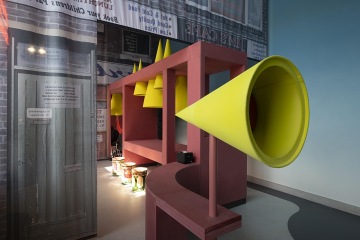
Alexandra: That's a great point. And it's something we're trying to explore as well at reSITE, of just kind of the importance of having lots of different interested parties involved in it. in regards to just, you know, again, public private space, you know, some might argue that it's only fair, and I use air quotes, to use a property if you take care of it, but how might you inspire those who who are using public space to care for that space collectively?
Manijeh: I think it's a really interesting question, because so much of the argument around what should be public and what should be private and even privatised public space, the way that they're currently being designed in new developments, it's often around issues of maintenance, and security that like governs like how they're designed, but also how they're maintained and encouraging that sense of care is really important.
And we've felt in the research that we've been doing that it's linked to a sense of ownership. So if you feel like that's your space, you're more likely to care for it. And that's why like, even through the signage, and through little touches like that, we've really tried to think how we can instil the sense of ownership and people by making them feel like this, like without necessarily having to own the this land, like how can you feel like you have the power to do certain activities there or to take certain decisions about it collectively, and a lot of the across the different rooms, a lot of the research, but also even the making of these, of the objects that you see within the spaces have been, like kind of done collectively.
The design almost manifests this kind of process that the more you know about these spaces, the more you know what you're able to do in these spaces, the more you should be able to care for them.
So in the ministry of common land, these big paper machine heads that were made by school children, and when they were making them, they were told stories about the kind of influential figures in the discourse around public lands. So everyone from Jane Jacobs to Colin Ward, and then they got really inspired. And then when they were making these heads, they had this additional significance. And then the fact that then those heads now sit in this ministry of common land, and they look down on you as in the space of the ministry. As you know, people come together to take decisions about their spaces, it feels really powerful, and there's the kind of I guess, the design almost manifests this kind of process that, you know, the more you know about these spaces, the more you know what you're able to do in these spaces, the more you should be able to care for them.
Madeline: Yeah, I mean, civic pride is just so important. I don't know if you, you know how in Tirana, in Albania, the mayor, he came into power. And he noticed there was like, really high crime rate, but he had next to no budget to do anything with. And so what he decided to do was paint, paint—paint the buildings, lots of different colours, and really bring joy into the city that way. And it saw a reduction of crime rates because people started to feel much prouder of the urban realm.
And so we're really interested in how you actually allow people to take ownership and feel that level of pride. And it's been really interesting over the past year, particularly in the UK, with all these lockdowns, and you started to see people getting to know their neighbours, for the first time in new ways, they started to get to know where they actually live, for the first time in new ways, and they started to sort of reclaim pieces of the city and pieces of space that weren't being used before, say, by planting trees or flowers, and sort of rewilding the city, by taking over the streets, once again.
You know, the street was the original kind of playgrounds. And then the motorcar became too dangerous for children to play. And that, you know, the past year, there's been a reduction in traffic. So once again, people could reclaim the streets and start to use them. And so we're really interested in how do you give the public the kind of tools and agency to be able to do more of that and start to really reclaim their public space so that they transform into places that are what they want to see, there's no kind of one size fits all model. So it's about how do you allow people to kind of reclaim those spaces.
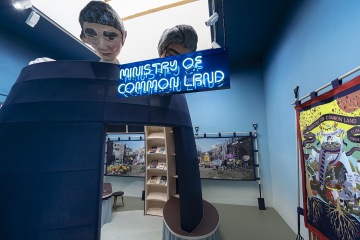
Madeline: Yeah, I mean, civic pride is just so important. I don't know if you, you know how in Tirana, in Albania, the mayor, he came into power. And he noticed there was like, really high crime rate, but he had next to no budget to do anything with. And so what he decided to do was paint, paint—paint the buildings, lots of different colours, and really bring joy into the city that way. And it saw a reduction of crime rates because people started to feel much prouder of the urban realm.
And so we're really interested in how you actually allow people to take ownership and feel that level of pride. And it's been really interesting over the past year, particularly in the UK, with all these lockdowns, and you started to see people getting to know their neighbours, for the first time in new ways, they started to get to know where they actually live, for the first time in new ways, and they started to sort of reclaim pieces of the city and pieces of space that weren't being used before, say, by planting trees or flowers, and sort of rewilding the city, by taking over the streets, once again.
You know, the street was the original kind of playgrounds. And then the motorcar became too dangerous for children to play. And that, you know, the past year, there's been a reduction in traffic. So once again, people could reclaim the streets and start to use them. And so we're really interested in how do you give the public the kind of tools and agency to be able to do more of that and start to really reclaim their public space so that they transform into places that are what they want to see, there's no kind of one size fits all model. So it's about how do you allow people to kind of reclaim those spaces.
Manijeh: And so much of the issue around privatised public space comes down to this issue of ownership. So often that you don't really know what looks like a public space to for all intents and purposes, as you pass by it in the city often ends up being privately owned, and you only find out that it is owned by a certain corporation or a landowner, once you try and do something on that land, and you usually get stopped from doing that, or you find a signage that tells you what you can't do. And we were really interested in this project called Who Owns England by guys Rob Solon, Anna Paul Smith, that was trying to map land ownership across England and, and also like then extending into Wales.
And they were really surprised to find out that when they started the project, only around 50% of all land in the UK was documented on the land registry. And even then it wasn't really clear who owned it. And the ownership of land is really important, because it obviously governs what you can do, but also where vacant land is like, could communities take that over. And so that was really important to us on the one hand in terms of making that more transparent.
But then also the sense of ownership that can kind of give people a strong feeling of care for their immediate environment and, and the kind of agency to change their public space. So it's kind of those two, two sides of ownership, like a more transparent understanding of what it means to own land, and then a kind of greater sense of responsibility over your public space that we're trying to encourage through this project.
Madeline: I suppose as well, sort of on the role of the architects, thinking about the level of control an architect has in a city and in public realm through design, and how often it's about sort of creating this framework that then allows people to take it over, like communities can come and use that in ways that you never would have imagined. Those are often the most successful spaces in the city.
How do you give the public the kind of tools and agency to be able to do more of that and start to really reclaim their public space so that they transform into places that are what they want to see?
So in London, for example, there's a place on the South Bank just south of the River Thames, which is sort of built as a sort of brutalist theatre complex. And at the lowest level, it's been taken over for decades now by skateboarders. And it's sort of like a theatre where people come and watch all these people skateboarding, but it's also a really important part of skateboarding culture, and it's graffiti there and stuff. And it was kind of it was going to be sort of, they were going to throw out the skateboarders a couple of years ago, and then this huge kind of protest movement started up to say, you know, this is actually a really important part of our city now.
And I think, for me, anyway, that's like, sort of a kind of sense of this being a really exciting, successful public space because the community has really taken ownership of that. And it's something that no one ever would have imagined would have happened.
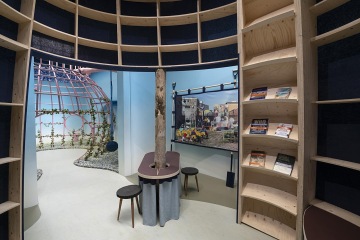
Alexandra: Wow. Yeah. We had actually something quite similar in Prague with the skateboarders in that same neighbourhood, and actually that is a big reason. Why I ask the same question, the same with the mayor of Tirana. He actually spoke at reSITE a couple of years ago, and kind of what he was saying about giving people reason to feel ownership of their space, I thought was really powerful. I think just to transition, a little bit of something else that you featured in your exhibition about teenagers and how they're often left out of the design process. Where I grew up, public space for teenagers was literally the shopping mall. And I see that even happening here in Prague, in kind of the outskirts of the suburbs of the city.
Madeline: It's the same in London, I grew up in London, and most of my teenage years were just sitting by a fountain and a shopping mall. And I think that's something that the room designers for that room have been super interested in, is how often, when people are designing for teenagers and young people, they design very active spaces. So it'll be like skateboarding parks, or basketball courts. But actually, there's a whole swathe of teenagers, often female, who just want to stick with their mates and do nothing.
And so it's like, how do you create those frameworks for them to inhabit, which don't feel threatening as well. Because often you'll find when you have groups of teenagers in a shopping mall, they'll just kind of get ushered on, because no one wants them to be there. And so it's how do you create those spaces that they can belong, and they can sort of take ownership over and feel like it is theirs?
When people are designing for teenagers and young people, they design very active spaces. So it'll be like skateboarding parks, or basketball courts, but actually, there's a whole swathe of teenagers, often female, who just want to stick with their mates and do nothing.
And so yeah, I think we completely agree with either of the importance of sort of intergenerational spaces, but also space, certainly for young people. And I suppose as well over the past kind of decade or so. Manijeh and I together have taught a number of workshops for teenagers and young people, for people like the sassy club trust. And through that we've just found It's so inspiring to work with young people to understand how they think about their city, and often sort of spaces that we would have assumed they felt very safe, and they might feel dangerous and and vice versa spaces that we would assume they wouldn't want to hang out. And they do. I think it's really interesting to work with them to understand what kind of spaces they would like to see. So that we're not just making sweeping assumptions, and providing spaces that they don't want to be in.
I read an article the other day about this group of teenagers who there was like a skateboarding park that was being built for them in a corner. And the female teenagers were skateboarding away from that park and narrow road. And it turned out the reason they were doing that was just they felt safe and near the road, because they were just scared to be somewhere that was completely caught off where no one could see them in case something happened. And I think having those conversations in the design of our public realm is really important. So we don't sort of make those mistakes of providing facilities that no one's going to use.
Manijeh: Which hopefully you were able to experience in the pavilion because vpr worked with a lot of teenagers to record a series of interviews that you can listen to, as you kind of moved through that climbing frame structure. And it was really important to all of us that it wasn't, you know, people speaking on behalf of teenagers or architects or trying to design for teenagers. But rather, teenagers shaping spaces on their own terms and in their own words.
It's a kind of global phenomenon that teenagers end up just getting stuck in like the leftover spaces.
And I think that it's funny that I grew up in India, and I think it's a kind of global phenomenon that teenagers end up just getting stuck in like the leftover spaces or like in shopping malls, because they're so vast, they tend to have these pockets of space where even if you get pushed out of all the shops, you can just as Maddie was saying, like hang around a fountain or sit there, but it's kind of almost encouraging teenagers that you have to buy something in order to stay in a space and like creating spaces where they can be themselves and make noise and hang out and not feel like there's a time limit or a price tag attached to it is so important.
And we were really keen that they didn't get forgotten in this discussion around privatised public space. And that we really think about them as a huge group of people that use our cities that don't really have any specific spaces for them to enjoy and have a sense of ownership of. So yeah, we're quite curious to see how teenagers actually visit the pavilion especially because as Maddie said, like, we were fascinated by the fact that the second largest group visiting the Biennale is Italian schoolchildren. So we're quite keen to see how they actually start to use that space and appropriate it in different ways.

Madeline: Yeah, I guess teenagers are the future and they have so many valuable things to say. So it's sort of taking stock of that and making sure everyone takes a step back to realise that and really value those voices here.
Alexandra: Absolutely. I think it's a little bit insulting. But oftentimes, they're not taken seriously. So I guess you're the aspect of the Ministry of Collective Data kind of looks to the future of, in a way where, you know, all these other aspects of it are quite tangible, but who has owns and data and especially in terms of smart cities and, and in our public spaces, kind of is a bit maybe more intangible for some people.
Manijeh: No, it's just, it's funny, because when we started doing this project was obviously before Coronavirus was a thing. And, you know, we were just really interested in kind of the intangible networks that sit in cities, and actually, you know, in format, what data is like collected about us as we use public space, but also like issues of consent, like how aware are we of how our data is captured, and what it's used for, and who owns it. So it's similar themes of access, use and ownership that keeps coming up, but in a kind of more invisible way. So you're not even aware of it. And it felt like, you know, it was something that was speaking to the future.
But I think the pandemic has kind of fast forwarded us like maybe into that future. And because we spend so much of our time now on online on these kinds of platforms, it's, it's really blurred even the digital kind of realms of public and private, and that we're so much more aware, I guess, of, you know, people seeing into our homes suddenly, and like when we join public events, it's like a very different kind of concept of what's public and what's private. And, you know, who knows what zoom is doing with our data.
How aware are we of how our data is captured, and what it's used for, and who owns it? It's similar themes of access, use, and ownership that keeps coming up, but in a more invisible way.
And I think what we were trying to do in all the rooms, really, is to break this binary between public and private. And in a similar way, technology isn't necessarily inherently bad. It's just, I think it's mainly like the transparency around who owns it and how it's going to be used. And someone on our team told us a really interesting story that actually made us think about this really differently about how when you're waiting at a bus stop, you don't, you would like to know the data from the bus company about when the next bus is going to arrive at the bus stop. But you probably wouldn't be as happy if the bus company was collecting your data to find out how long you'd been waiting at the bus stop, which bus you were waiting for.
So a lot of it is about power structures, and who holds the data, and who has access to it. And, you know, facial recognition technology is something that's really considered to be automatically negative when it's used in privatised public space. And it has a lot of racial bias and gender bias embedded into it. But then at the same time, depending on how it's used.
In India, there was an article saying that it was used to locate 3,000 missing children in a short span of time. And so it's really about kind of thinking of different ways to apply this, and being more transparent about how it's used. So in that room, you're kind of tracked when you enter, but then, what we're really trying to show you is that if you consent to this being your data being captured as part of a public database, you could actually decide how that could be used. And it could actually be used to benefit [by] changing the design of our cities to better serve—like who actually uses them, and like how they use them. So it's trying to push up this idea of, I guess, as you were saying, the future of smart cities, and how to think about that in a more bottom up way.
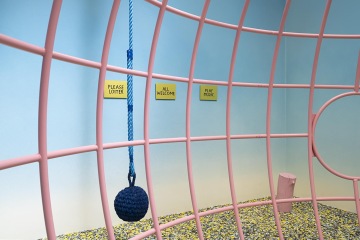
Madeline: Yeah, it's really a crazy amount of data we're all constantly giving over. And we don't really know who it's to or what they're doing with it. It's so like, it's not transparent at all in the slightest. I think a lot of what we're looking at in this project is how land ownership isn't transparent. Data ownership isn't transparent. How do we therefore allow this kind of collective ownership of this data so that we can collectively ensure it's used for public good and benefit rather than things that just are quite evil, where it can all go horribly wrong.
And so there are some really interesting examples. For example, there's an app called CityMapper. And it's a bit like Google Maps, which people use to find sort of directions to go places. And they started tracking where people are trying to go so that they don't have direct bus routes. And then out of that they found where to start putting on sort of temporary bus routes and at what times to do that as well, like what times are very popular times for people to do that.
Data ownership isn't transparent. How do we therefore allow this kind of collective ownership of this data so that we can collectively ensure it's used for public good and benefit?
A few years ago, as well. There was a really interesting protest in Spain, outside the Spanish Parliament where, ironically, the parliament with the Spanish government, we're trying to introduce this new law against people protesting outside of the Parliament. So instead of physically protesting, there was this holographic protest, which allowed people to be kind of digitally present in the space but not physically present there. And that feels quite exciting that suddenly you can start to have a physical presence somewhere without physically being there.
So the kind of potential for that in allowing accessibility for people to protests and things like that, without having to physically be somewhere is super interesting. And I suppose we're kind of really interested in this kind of boundary between the physical and the digital. And this past year, we sort of all been thrown into this digital world, but it's going to be super interesting going forward to see how we sort of grapple between the two.
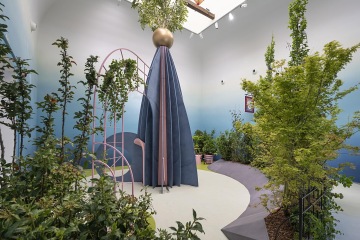
Alexandra: Absolutely. And I think it's going to be one of the biggest conversations that we have in the next decade. But all very good points. Thank you so much for sharing.
Madeline: Someone told me the other day that zoom recording absolutely everything, every single zoom conversation is being recorded. But no one knows what they actually want to do with that, it sounds like they don't even know, they just know, at some point in the future, it will be really useful data for them. And so it's just crazy to think that that's the level of documentation and data kind of ownership that we're giving up every time we have a zoom call. I'm sure all the other platforms are doing it to seem alright.
I think belonging I guess means different things to different people.
Alexandra: Wow. So maybe an underlying theme of all of this is belonging. So in your opinion, the feeling of belonging—what creates that, within these spaces?
Madeline: I think, I mean, that feeling of belonging, I think you've hit the nail on the head, that is ultimately what we want everyone to feel in their urban environments that they do belong. And for us, that is about giving people that sense of ownership, that inclusivity, that accessibility over their public space, the kind of power to transform public spaces around you to provide spaces that you want to see and you want to use. You know, it's ultimately really creating inclusive accessible spaces that offer everyone, and everyone kind of has that sense of ownership and therefore wants to care for it and feels a part of it.
Manijeh: Yeah, I think belonging I guess means different things to different people. And, you know, we wanted to think about what does it really mean to access the space like, even though on the one hand, there's physical barriers that prevent you from accessing certain privatised public spaces, but there's a lot of intangible barriers that make people not feel comfortable to walk into a pub, or to spend a lot of time, you know, in the shopping centre, or in spaces on the high street? And how do we actually address those, like, how do we kind of be more inclusive, and who we're designing for whether it's people of all ages, genders, abilities, backgrounds, and so that was something that was really important to us like that.
There [are] physical barriers that prevent you from accessing certain privatised public spaces, but there's a lot of intangible barriers that make people not feel comfortable to walk into a pub, or to spend a lot of time in the shopping centre, or in spaces on the high street.
It's not about I guess, trying to create one size that fits every solution. And every person, I think it's about really trying to think about, like, what are spaces that you'd like to spend more time and that have a range of activities for different people, or could be cross programmed at different times of the day. And so even in the Garden of Delights, when you get back into [the] inside of it, there's lots of different types of spaces that, you know, maybe different types of people would enjoy. But that would allow you to spend more time in those kinds of spaces that often you feel like you have a kind of time limit on.
Whether you want to sit and spend some time alone and just contemplate or meet friends and have a conversation, or, you know, cook together or play. There's a whole variety of things that people of different ages and across generations might want to do together. And I guess I think inclusivity goes hand in hand with belonging. And that's kind of what we were trying to do across the different spaces in the pavilion like create different different approaches that kind of bring those ideas together.
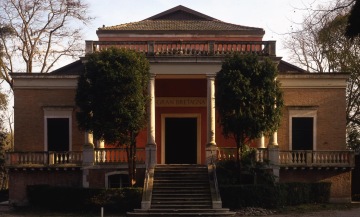
Madeline: Yeah, I suppose this is this kind of making everyone feel welcome and listened to. And I think the high street of exchanges in particular actually really picks up on these kinds of themes of belonging. So the high streets kind of split into this kind of “listen, share, act”. So listen, you sit in this Barber's chair, and you listen to the sounds of Sheffield High Street, and that's all about how when you pay to get your haircut. You're not just getting your haircut, you're also getting a conversation with someone which could be so important, especially if you like an old person who you know might be the only conversation you have that week.
And then the next part of the installation is about sharing and that's based upon a kind of project called Sheffield Foodhall in Sheffield, which Studio Polpo, the rim designers for that room were involved in and Sheffield futile is this pay as you feel project. So the food hall sort of takes waste food from surrounding cafes and grocery shops, and then they make meals that anyone could come and eat, and you just pay whatever you can afford [or] whatever you feel. And then as part of that, they also have workshops, dancing classes—it's completely transformed as this community space and all the time, you're just paying what you can afford, and what you can feel. And say this kind of barrier between volunteers and consumers is blurred.
And I suppose that's kind of his ultimate feeling of belonging for the community, because you're accepted, anyone can go there, anyone can do whatever they want. And you know, you don't have to be of a certain standing in society of a certain group that’s super exclusive.
Manijeh: And another nice example is this big banner that you see in the ministry of common land, which is something that's part of the room designer of that space, public works as practice. They do these things called situated images that try, and document things like what happens at community meetings, because often it's people sitting around and just sipping cups of tea. But what they were trying to show is actually the bigger ideas and the kind of the kind of agency that's embodied in those conversations that then leads to lots of spaces in the city being transformed. So they created this amazing, like almost tableau vivant over the course of a day, where they got different groups of people that have been working on this project in South London, over several years to come together and kind of reconstruct historic scenes and collectively make some of these like fantastical props.
nd you almost seem like a kind of time lapse as you move across the banner of all these different ways in which different groups of people have been engaging with each other, but also with these different sites to really rethink what these spaces could be. And all the people kind of involved have actually actively been involved in transforming the site of a time to create adventure playgrounds, community gardens, community kitchens. And so the image really captures that. But it's also like it was a really amazing day because we got to go be part of it. And it was right when lockdown rules went east. And it was like the first kind of social gathering. It was like both the celebration and this kind of incredible collective making of an exhibition artefact rolled into one.
Madeline: Yeah, it's those thresholds, isn't it? Because it's things like the pub even though we've said the pub is more than a public toilet, not everyone will feel comfortable just going into the pub, and you still have to sort of buy a pint to then be able to use the toilet. So it's how do we break down those thresholds so that, you know, everyone can use a space no matter what. Wow. And the pub is sort of exploring that, as a roommate, you know, is looking at going beyond just being somewhere for drinking and somewhere that everyone can use.
Alexandra: I think that's all the questions I really have. Is there anything else you feel like we didn't talk touch on that you might want to speak about or add to the conversation that you feel is, is needed?
Manijeh: I think maybe like the fact that the exhibitions meant to kind of provoke questions, rather than necessarily provide solutions. So the main kind of text in the space, like, the only text that we really try to keep in the space, other than the signage? Are these questions in each of the rooms kind of inviting you to think about pub-size streets, garden squares, like all these different examples of public space in new and exciting ways? And just to get you to maybe apply that to your own public spaces. I think the overall question that the exhibition is asking is really, why can't all public spaces be designed as Gardens of Delight? So we hope that that's what people take away with them.
Madeline: Yeah, we're really inviting everyone to become part of this conversation. And that's why we've got all these questions because we want everyone to be part of this. It's not about architects just suggesting what the solutions will be. It's about all of us working together to transform our cities and our urban spaces, saying that they are more inclusive, and that they are Gardens of Delights.
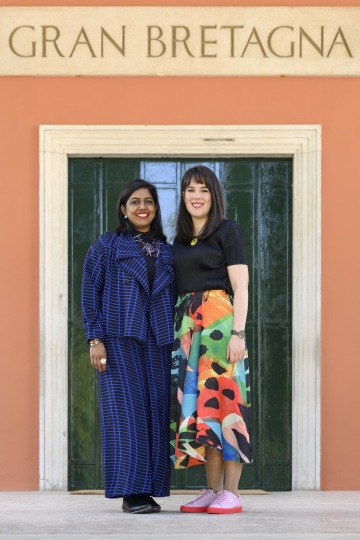
Alexandra: Well, I definitely got that from that. I really loved it. And I loved the questions and stimulated and I think that was, you know, you hit the nail on the head there.
Madeline: Well, thank you so much, honestly, like, yeah, it's been so great to speak to you and like, it's amazing to hear your kind of feedback from the exhibition and how it resonated with you. Yeah, it's
Manijeh: a really lovely way to see whether it worked or it didn't. I guess we've been thinking about it for so long, and, you know, it's been, it's been quite a process to put the exhibition together. So it's like really exciting to hear your experience having visited it,
Madeline: especially as we haven't been able to go out there ourselves yet. And it's just amazing to hear that this conversation is transcending borders. And it's not just a sort of British-UK conversation, this is a really kind of important international conversation about our public space.
Alexandra: It absolutely is. And it really, you know, it connected a lot of dots even for me.I can't say enough nice things. But you know, really, the pleasure is all mine. So yeah. Thank you.
Madeline: Hopefully, we'll be able to meet properly someday and continue the conversation.
Alexandra: I would absolutely relish that. Thank you.
Yeah, we would love that, too. Thank you so much.
Manijeh: And it made us think about so many different things. So, yeah, it's a kind of ongoing project in so many ways.
Alexandra: And I think it's a conversation that needs to continue to happen. And I will say again,I really think just how you addressed it using humour made it so tangible. And I felt like those were the most powerful takeaways that I took from it.
Manijeh: Thank you. Lovely to hear. And I think coming out of the past year, I think humour and a sense of optimism about the future of these public spaces and how we can all come together is just so important. So it's really nice that that resonated and that it's a theme kind of across the whole BNR layer. Because, yeah, we have to be optimistic going forward.
Madeline: Yeah, we want to create more joyful places. And yeah, I think we love addressing things through kind of both a serious and more lighthearted approach. Like that's how you get the most interesting conversations.

So, what is the Biennale for, if not to influence and provide access to new ideas and ways of viewing architecture and spaces we share. The curation behind both Austrian and British pavilions share a common thread of accessibility. Their immersive interventions help the viewer experience what accessibility means and question the limits. The installations communicate in a way that is comprehensible to a wider audience—all while being visually very appealing.
I would like to personally, and on behalf of reSITE, thank you all for tuning in, for taking this journey with us as we navigate building a podcast in the midst of a pandemic. After this episode we will be taking a summer break for the coming months, and returning in autumn 2021 with a bigger, better and longer season 3.
We have loved getting to create this podcast, and we hope you’ve been enjoying it just as much. Reaching a new audience, on a new platform with the same mission—elevating people and ideas to improve the urban environment—in the middle of a pandemic has been what we feel to be an important action. Also important to us is that these ideas remain accessible and free.
As a nonprofit, we are only able to produce this podcast thanks to the generous support of the City of Prague, the Czech Ministry of Culture, corporate sponsors, private philanthropists, and our network of passionate architecture and city lovers, like you. If you would like to support us as a patron, sponsor or strategic partner, please get in touch with us at podcast@resite.org. Your support allows us to continue sharing ideas to inspire more livable, lovable cities.
This episode was directed and produced by myself, Alexandra Siebenthal and Radka Ondrackova and with support from Martin Barry, Nikkolas Zellers, Weronika Koleda, and Anna Stava, as well as Nano Energies and the Czech Ministry of Culture. It was edited by LittleBig Studio.
More Venice Biennale curators featured in this episode:
Venice Architecture Biennale Nordic Pavilion: What We Share with Siv Helene Stangeland + Reinhard Kropf
reSITE is back with a special two-part Design and the City episode covering the long-awaited Venice Architecture Biennale to explore the question “How will we live together?” We spoke with exhibitors of the Nordic Pavilion, Siv Helene Stangeland and Reinhard Kropf, entitled What We Share about the inspiration behind their co-living experiment in Stavanger, Norway, which they not only designed, but also occupy, along with 65 other tenants.
Venice Architecture Biennale U.S. Pavilion: American Framing with Paul Andersen + Paul Preissner
reSITE is back with a special two-part Design and the City episode covering the long-awaited Venice Architecture Biennale to explore the question “How will we live together?” Part-one covers the U.S, Pavilion curators, Paul Andersen and Paul Preissner as they reexamine humble softwoods and their place as the literal bones for American homes in their exhibition entitled “American Framing”.
Venice Architecture Biennale: How Will We Live Together? [Part 1]
reSITE is back with a special two-part Design and the City episode covering the long-awaited Venice Architecture Biennale to explore the question “How will we live together?” Part-one covers the U.S, Nordic and Luxembourg Pavilion curators for their use of timber and wood construction to answer this years pressing question.
Venice Architecture Biennale: There Are Walls That Want to Prowl, Lukas Feireiss + Leopold Banchini
reSITE is back with a special two-part Design and the City episode covering the long-awaited Venice Architecture Biennale to explore the question “How will we live together?” with curators Lukas Feireiss and Leopold Banchini to discuss their definitions of shelter, application of wood structures, degrowth models and retrospectives to rethink how we will live together.
More from Design and the City
Trey Trahan on Building Sacred Spaces for Connection
This episode of Design and the City features the founder of Trahan Architects, Trey Trahan on the importance of creating sacred spaces devoid of clutter that make way for that human connection, his definition of beauty, and the potential regeneration holds, presenting a different side of that coin.
Tim Gill on Building Child-Friendly Cities
A city that is good for children, is good for everyone--and idea we explore with Tim Gill, author of Urban Playground: How Child-Friendly Planning and Design Can Save Cities, on this episode of Design and the City. Photo by Els Lena Eeckhout.
Why is Birth a Design Problem with Kim Holden
Can rethinking and redesigning the ways birth is approached shift the outcomes of labor and birth experiences? Can it be instrumental in improving our qualities of life--in our environments, in cities, and beyond? Architect and founder of Doula x Design Kim Holden join Design and the City to explore how she sees birth as a design problem. Photo by Kate Carlton Photography
The Architecture of Healing with Michael Green + Natalie Telewiak
Michael Green and Natalie Telewiak love wood. These Vancouver-based architects champion the idea that Earth can, and should, grow our buildings--or grow the materials we use to build them on this episode of Design and the City. Photo courtesy of Ema Peter
